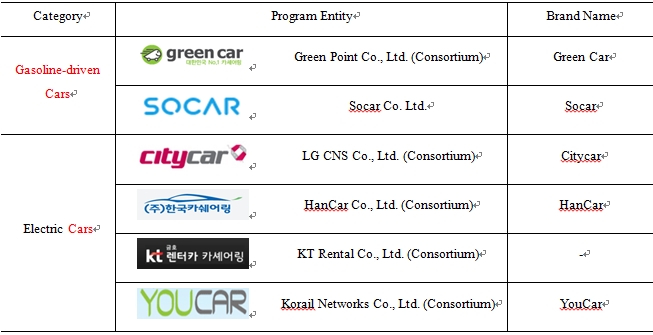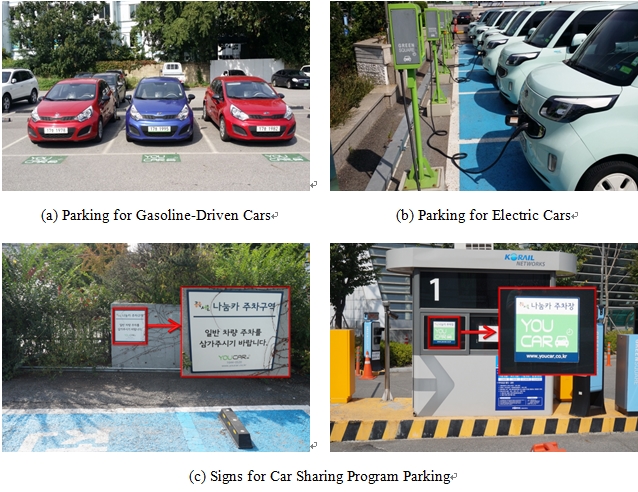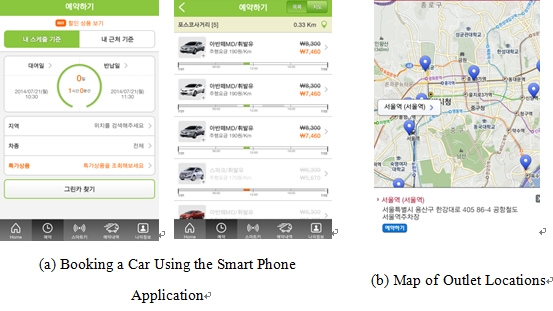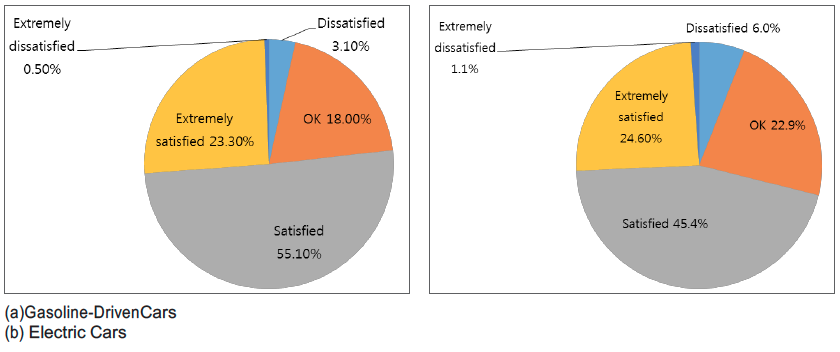Shared Transport: Car Sharing in Seoul (Nanum-Car)
Background
As people depend more heavily on automobiles and increasingly drive their own vehicles, there are related societal costs such as air pollution, higher demand for fuel, and heavy congestion. The City of Seoul has responded through various policies to reduce the traffic volume created by private vehicles. Since the mid-1990s, these policies include: a transportation demand management system for companies (1995); the congestion fee on Namsan Tunnels 1 and 3 (1996); the parking threshold program (1997); and the 7-day road space rationing (2003). The city has adjusted policy implementation and adopted new measures to reflect changes in the transportation environment.
Process
In September 2012, the Mayor of Seoul declared the beginning of the “Seoul: A Sharing City” campaign, which focuses on bringing back a tradition of sharing, which has a long history in Korea, to resolve socioeconomic issues in the city. Officially referred to as the “car sharing service”, car sharing was particularly touted as one of the most important programs in making Seoul a “sharing city”. For this program, the City of Seoul publicly recruited contestants; reviewed operating plans and services for citizens, and strategies to promote public interest; and signed a partnership agreement with 2 private companies. In a public contest held in February 2013, the program was named “Nanum-Car”. In an effort to encourage the use of eco-friendly cars, Seoul also initiated an electric car sharing service in May 2012 before the general car sharing service began, but due to delays in making an agreement with the program entities as well as construction of the appropriate infrastructure and system integration, the program officially began in May 2013, 3 months after the official introduction of the gasoline-driven car sharing service.
Starting the Car Sharing Program (Nanum-Car) in Seoul: An Overview
- September 2012: “Seoul: A Sharing City” campaign initiated
- October 2012: Opened bidding for operators of the car sharing program (requirements such as dedication to the public interest announced).
- Bidding parties (Program Entities): Submitted proposals on plans for operation, services, and strategies to promote the public interest.
- January 3, 2013: Partnership agreement signed with Green Point Consortium and Socar.
- Selection and agreement: Committee created to choose partners, verify ability to perform the program, and sign the agreement.
- January 21, 2013 – February 3, 2013: Citizens invited to enter a naming contest for the car sharing program.
- February 20, 2013: Membership drive for Nanum-Car; Service begun.
Starting the Electric Car Sharing Program in Seoul: An Overview
- May 2012: Plan developed for pilot electric car sharing program.
- July 2012: Agreement signed with program entities
- August 2012: Council created with 4 electric car sharing program entities (184 cars).
- August 2012 – March 2013: Infrastructure built & system integrated for electric car sharing program; 212 charging stations built (including 28 “Express” stations).
- April 2013: Citizen testers program launched for electric cars.
- May 2013: Electric car sharing service initiated.
- July 2013: Program transferred to Seoul City Transportation Headquarters (from the Seoul City Climate Headquarters).
.
<Table 1> Program Entities in the Car Sharing Program (Nanum-Car) in Seoul

Operation
The car sharing service started with 292 outlets and 492 cars in February 2013 and had grown to 850 outlets and 1,816 cars as of November 2014. The outlets are located near public parking lots run by the local administrative districts of Seoul or by public institutions, and car rentals are possible at anytime all over the city (refer to Figure 1). The plans for the electric car sharing service are to build additional infrastructure such as dedicated parking spaces for electric cars and the installation of electric chargers.
<Figure 1> Car Sharing Service Outlets in Seoul
.jpg)
Source: Seoul Transport Operation & Information Service (TOPIS)
<Figure 2> Parking Spaces for the Car Sharing Program

Characteristics
Membership-based or Hourly Services
Unlike the predominant type of car rental system, the car sharing service rents program cars, stationed across the city, to people who have applied for and received membership and booked a car online (via mobile phone or ARS) for their desired length of time before they arrive. This can be seen in Table 2. With regular rental services, a customer rents a car by the day, while with the car sharing service members can rent by the hour, significantly reducing the fixed cost for people wishing to use a car for a shorter period of time. Because the same car can be used by several people each day, the operational efficiency is higher than regular car rental services. Outlets located across the city and insurance coverage included in rental cost makes the program convenient for users.
<Table 2> Car Sharing Vs. Car Rental: A Comparison
|
|
Car Sharing (Nanum-Car) |
Car Rental |
|---|---|---|
|
Users |
Members |
Anyone |
|
Rental Time Segments |
30 minutes (available 24 hours/day) |
1 day (available only within business hours) |
|
Outlets |
All across the city |
Designated branches |
|
Payment |
After use |
Before use |
|
Contract Type |
Upon first applying for membership |
New contract each time |
|
Pick-up & Drop off Process |
Automated |
Personnel required |
|
Insurance |
Included |
Additional |
Source: Car Sharing page on the Seoul Metropolitan Government website (http://traffic.seoul.go.kr/archives/9344). |
||
Easy Rental through Advanced Information Technology
Members are able to preview the cars available and the associated outlets through many media forms such as the internet, mobile devices or ARS. A smart key embedded in their membership card or smart phone application can be used, making pick-up and drop-off simple and convenient.
<Figure 3> Picking Up/Returning Cars with Smart Key or Membership Card

<Figure 4> Using a Smart Phone Application to Book a Car

Platform to Encourage the Use of Electric Cars
The car sharing service includes electric cars as well, with an aim to boost the electric car market in Korea and take action to address climate change by reducing pollutants and greenhouse gas emissions. Seoul’s electric car sharing program uses the Kia Ray and Renault Samsung SM3 ZE, both developed in Korea. Korean cars were selected to boost the domestic market, but the service will offer other types of electric cars that include international models to offer a wider range of choice.
The City of Seoul signed agreements with 4 private companies (such as Citycar): Seoul provides benefits such as access to public parking lots, while the partnership companies provide the electric car sharing service. In addition to the normal-speed chargers at the electric car sharing outlets, “Express” chargers were installed at 32 outlets for those wanting a faster charge.
<Figure 5> Express Charging Stations
.jpg)
<Figure 6> Using the Electric Charger
.jpg)
Source: City Car website
Seoul’s Policy on Assistance for the Nanum-Car Program
Purchase Subsidies for Program Entities & Discounts for Users
The City of Seoul provides different assistance programs to benefit the car sharing program. Car sharing service providers are given a 50% discount for parking in public parking lots (as of October 1, 2013, a discount of KRW 5.3 million has been given for the 93 Nanum-Car vehicles); electric car sharing service providers receive a subsidy on the purchase of the electric cars (KRW 15 million per car from the city; KRW 15 million from the national government) and free installation of normal-speed chargers. Seoul provides more benefits as part of the integrated transfer discount scheme: members using public transit to get to the car sharing outlet within a travel time of 30 minutes receive an average discount of KRW 300 – 1,000 per use.
Integrated Information & Service Management System
The City of Seoul built a user-friendly system by integrating various individually-run services that were independent of each other, resulting in user inconvenience. This integrated system allows members to access services provided by multiple entities with a “multi-card”, while in the past membership with each provider was necessary. The system also includes an integrated gasoline-driven/electric car information service: the outlet/car search feature is now integrated into the TOPIS website, which previously had been provided by each car sharing service provider.
Seoul also created a service management system to address complaints and issues raised by users, such as additional fees charged to a previous user in the event the next user complains about the cleanliness of the car, or in the event a user fails to report any incidents or accidents in which the car is involved.
Major Achievements
Continuous Growth in Membership & Users
The car sharing program allows non-owners access to cars, attracting some 60,000 members when the service was first launched in February 2013. Membership growth slowed due to inadequacy of the operating system, the small number of outlets, and insufficient promotion, but this changed as services were improved, more outlets appeared, and promotion became more common. As seen in Figure 7, the number of members for the car sharing service had reached 350,000 by November 2014.
The average number of users per day has also steadily increased. Growth has been particularly high since 2014. In November, an average of 2,775 members used the service each day, with an average time per use of 4 hours and 7 minutes: 4 hours and 20 minutes (70 km) per use for gasoline-driven cars and 3 hours and 54 minutes (64 km) per use for electric cars.
<Figure 7> Growing Car Sharing Service Members & Users Per Day

Source: Internal data, Seoul Metropolitan Government
High Satisfaction Rate
In the early days, complaints were directed towards the inconveniences of the car sharing service. Thanks to continued improvement, users are highly satisfied with the service now, according to a survey conducted by the City of Seoul in November 2013. Of 5,950 respondents, most were satisfied: 23.3% said they were “very satisfied” while 55.1% were “satisfied”. While satisfaction was high in terms of the rental system and use, it was lower in terms of car condition, number of outlets, number of cars, and fees. According to the results of a survey conducted via the “Policy e-Poll” on the city website, the car sharing service ranked as the 5th most important program in Seoul in the first half of 2013, after the program to phase out a nuclear power generator (1st), night bus (2nd), the Clean Apartment project (3rd), and the program for Patient-friendly Hospitals & Clinics (4th). However, many members requested that the program be expanded and allow one-way trips.
A study by the city on the electric car sharing service in 2013 also revealed that many were satisfied: 24.6% were “very satisfied” while 45.4% were “satisfied”. The aspects of the service that they were satisfied with were: positive contribution to preserving the environment; vehicles (noise levels, speed, drivability, maintenance, cleanliness); reduced transportation costs; and ease of booking. On the other hand, the instances where members were not satisfied with included time of use, location, and fees. Many complaints were also given regarding charging the electric cars: problems with the charging facilities and the limitations on distances that could be travelled on a single charge.
<Figure 8> Satisfaction with Car Sharing Service (Survey Results)

Source: (a) Internal data, Seoul Metropolitan Government, (b) Seoul Metropolitan Government (2013)
Reduced Household Expenses
According to the study by the City of Seoul, the car sharing service allows users to avoid the cost of vehicle depreciation, long-term insurance, and vehicle maintenance, with annual savings depending on the number of times a member uses the service. For example, annual cost for car owners who drive twice a week is KRW 4.26 million in total (KRW 1.86 million in depreciation, KRW 850,000 in fixed expenses, and KRW 1.55 million to run the vehicle). However, a twice-weekly user of the car sharing service spends KRW 1.7 million in total – an annual membership of KRW 30,000 and KRW 1,674,400 – about KRW 2.56 million less than car owners. Based on 5-days-a-week use, a car owner spends KRW 6.3 million while a car sharing service user spends KRW 4.18 million: KRW 2.08 million less a year.
Limitations & Needed Improvements
Potentially Ineffective for Transportation Demand Management
Analysis of car sharing service user patterns shows that a majority of users (83.8%) are in their 20s and 30s – the age group that usually uses public transit as they are less able to afford a car purchase – and this may actually work against the policy designed to curtail the use of individual cars. It is also estimated that the shared cars are highly likely to be used on weekends; the percentage of weekend users was 37.5%. In other words, the effectiveness of the car sharing service in terms of managing transportation demand is rather limited, considering how relatively low the use of shared cars is and that people in their 20s and 30s who are less likely to own a car account for the majority (83.8%) of all shared car users. In the long term however, the steadily growing number of users, especially in the young adult group, may discourage people from owning a car in the future. It is therefore necessary to wait and see the effectiveness of this program rather than only focusing on the immediate negative aspects.
<Table 3> Percentage of Car Sharing Service Users by Age Group (2014)
|
Category
|
20s
|
30s
|
40s
|
50s
|
60s or older
|
Total
|
|---|---|---|---|---|---|---|
|
User Percentage
|
44.2%
|
42.2%
|
10.0%
|
3.5%
|
0.1%
|
100%
|
Source: Internal Data, Seoul Metropolitan Government. |
||||||
Limited Ability to Make One-way Trips
One common request made is to allow one-way trips so that users do not have to return to the outlet where they rented the car, but can instead return the car to an outlet more convenient for them. Currently, one-way trips are possible on a very limited scope, but return trips are mostly required due to the likely imbalance between number of cars at rental points and the number at return points. At this point in time, the one-way trip option is not likely to be expanded when the demand for the service is limited. However more widespread use of the service and expansion of the infrastructure will make this more of a possibility.
Implications
The major difference between the car sharing services provided in 60 countries around the world and that offered in Seoul is who provides the service. Most services in other countries are provided by the private sector. In Seoul, the service is provided by the private sector as well but the program itself was implemented by the City of Seoul. The service in Seoul is different as it grew rapidly, boosted by policy support (subsidized use of public parking lots, subsidies for the purchase of electric cars, etc.) by the city.
Before launching the car sharing service, Seoul sought and assessed proposals to find suitable providers before signing an agreement with those who could provide quality service. To come up with the basic policy directions and minimum service requirements, meetings were held with experts, policymakers, and industry leaders to collect ideas and expertise, after which the city adopted a policy. To support the private-sector providers, the city revised its ordinance on parking lots and decided to allow these providers to use public parking lots at a discount. The service is provided by the private sector, but the brand was named by the city. The city also selected the providers and maintains service quality. The car sharing service in Seoul is a partnership between the public sector and the private sector.
Despite the limitations mentioned earlier, the car sharing service is geared for success considering the growing number of users and increasing demand. In order to meet the originally-intended goals in terms of transportation demand management, the following policy considerations are necessary:
First, the car sharing service needs to be more self-sufficient and requires a platform on which it can expand. For the service to be sustainable, it needs more users to the point where profitability can happen, which will require effective advertisement and promotion strategies by the city and the providers. Operation of the service will need to be more proactive and reasonable, responding immediately to user needs and relocating outlets to meet user demand.
Second, the extent of program expansion should be reviewed in order to ensure service quality. To do this, the role of the service in Seoul’s transportation environment needs to be defined, also in consideration of the roles of other modes of transport (buses, taxis, etc.). The service should not be competing with other modes of transport, but rather should make up for the shortcomings of the other modes. This will significantly enhance mobility for the public.
Third, the public nature of the car sharing service should be emphasized. Shared cars may be used to enhance the transportation experience for groups of people who do not have much access to passenger cars (e.g., low-income families, people with disabilities) or certain regions (e.g., traditional markets, community-building project areas, regions not reached by public transit). In terms of transportation demand management, the service also needs policies such as different fees for peak or non-peak hours or discounts to people who have sold their cars. In addition, eco-friendly cars should make up a higher percentage of cars offered and those chosen by users, to ensure that the service becomes greener.
Fourth, a model for safe operation and management is necessary. Transportation safety-related institutions can help analyze the types and causes of accidents and incidents, based on which a relevant safety manual can be prepared and distributed for users of shared cars.
References
Go Jun-ho, Lee Su-jin, Yang Ji-yeong, 2014, “Status & Direction of the Car Sharing Program (Nanum-Car) in Seoul”, the Korean Society of Transportation, Transportation Technology & Policy, Volume 11, Issue 4.Seoul Metropolitan Government, 2013, “Monitoring Evaluation of the Pilot Electric Car Sharing Program”.